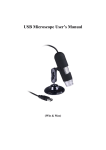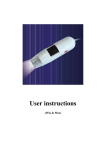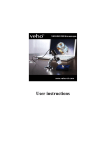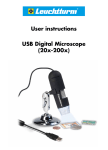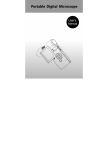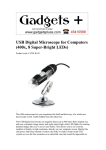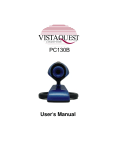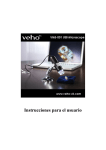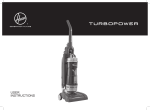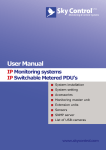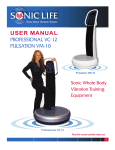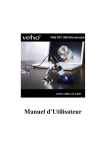Download Hi Liliane,
Transcript
User’s Manual (Win & Mac) Introduction Thank you for your choice of our product - it is a high-tech while easy to use Digital Microscope. With this unit you may see a unique & “bigger” world. It is applicable in many fields such as visual inspection on electronic components, and materials in a full range of uses, beauty shop and education. We recommend you reading this manual FIRST to get the best out of this unit. Computer System Requirements: Windows 98SE/ME/2000/XP/VISTA & Mac OS X 10.5 or above P4 1.8 or above RAM: 256M Video Memory: 32M USB port: 2.0 CD-ROM Drive Technical Specifications Image sensor 1.3 Mega Pixels (interpolated to 2M) Still capture resolution 1600x1200, 1280x960, 800x600, 640x480, 352x288, 320x240, 160x120 Video capture resolution 1600x1200, 1280x960, 800x600, 640x480, 352x288, 320x240, 160x120 Color 24 bit RGB Flicker Frequency 50Hz/60Hz Frame Rate Max 30f/s under 600 Lus Brightness Magnification Ratio 20X to 400X Shutter Speed 1 sec. to 1/1000 sec. Video format AVI Photo format JPEG or BMP White balance Auto Exposure Auto Light source 8 LED (switchable by software) 1 PC interface USB2.0 Power source 5V DC from USB port Operation system Windows2000/XP/Vista, Mac OS X 10.5 or above OSD language English, German, Spanish, Korean, French, Russian Bundle software MicroCapture with measurement & calibration function Size 125mm (L) x 33mm (R) Install the software Insert the driver CD into CD-ROM Drive and this will automatically display the following interface: 1. Install the driver by clicking Microscope Driver A Install Shield Wizard will walk you through the whole process. Click the “Next” button to continue. In this process a message box will appear on the screen. Please click on “Continue Anyway”. (Some versions of drivers may not be tested by Windows Lab testing. However it is safe for both your software and hardware) 2 2. Install the MicroCapture software Click install MicroCapture software and then reboot the system when asked. 3. You can also browse the User’s manual in PDF format and the CD contents by choosing the corresponding menus. Connecting the Microscope to Computer 1. When using a Windows XP operating system, the following “Found New Hardware Wizard” screen will appear upon connecting the unit to your PC via the USB port. Select the “Install the software automatically (Recommended)” option and click the “Next” button. 3 2. Click the “Continue Anyway” button on the message box that appears. 4 3. Click the “Finish” button to exit the wizard. Now you may begin to use the Digital Microscope. 5 Quick Look at the Digital Microscope 1) Use the FOCUS WHEEL to focus the microscope on the subject. 2) The SNAPSHOT BUTTON enables user capture snapshots by hardware; please refer to photo capture by software later. 3) Calibration ruler provides the magnification ratio at which a focus got. 6 Start Microscope Connect your Microscope directly to your PC USB port, start the software by clicking the icon generated on the desktop after installation and then you will see the following box popped up. 1. Once the Microscope is disconnected from your PC USB port, box showed on Step 1 will pop up as “No Device detected, please connect your Microscope directly to your PC USB port.” Change preview size 7 You can change the preview size by the following operation: Note: The size of the photo taken is equivalent to the preview size selected in the Options menu/Preview Size. Rotate the output image angle You can rotate the output image clockwise and counter-clockwise. 8 Date/Time You can display or turn off Date/Time by the following operation: Language You can choose On Screen Display language by the following operation: 9 Skin You can choose to change the appearance of your MicroCapture screen by the following operation: Full screen 1. You can enter & quit full screen mode by: 1) Double-clicking the preview area. 2) Clicking the full screen icon: 3) Choose Full screen mode from menu. 10 When in full screen mode, click on the Full screen icon to turn off and restore toolbars and menus. Preferences 11 Major operations under preferences are as follows: 1. LED on/off You can choose from Aux LED Mode the LED status as Off/On/Auto and click Apply. Click OK to continue. 2. Brightness You can adjust the brightness best suitable for object observed. 3. Image Mirror and Image Flip option: Image Mirror and Image Flip options are also available. Please ensure that these options are deselected for correct image capture. Capture 1. Photo capture You can take photos by either of the following ways: 1) Click the camera button 2) Choose Capture and then click Photo 3) By pressing F11 12 Captured photos are saved automatically and image thumbnails will be available on the right side of the MicroCapture screen for further editing. For editing photo, please refer to later operations. 2. Video capture 13 You can record video by either of the following two ways: 1) Click the video camera button 2) Choose from the menu bar Capture and then click Video When recording, there is a red dot flashing on the video camera button. The video is saved in AVI format. Stop capture: 1) Click the flashing video camera button 2) Choose Capture and then click Stop capturing Note: Please note the best pixels for video capturing is 640x480. 14 Edit photos 1. Preview photos 1) Clicking on an image thumbnail will display the image selected on the preview area, with its size displayed on the left-bottom corner. 2) You can double click the image thumbnail and an independent preview box will pop up as shown below: 15 2. Save photos You can save photo by right clicking on the thumbnail and then choose Save. The file can be saved in either jpeg or bmp. The jpeg size in which the photo is saved is the maximum allowed for jpeg. You can choose to decrease the size by adjusting quality. Click the Advanced button to view and select jpeg save options. 16 3. Delete photos By right clicking and then choose Delete, you can delete the selected photo Or, at the independent preview box you can choose delete icon to delete the previewed photo. 4. Copy photos Right click on the thumbnail and then choose Copy. Edit videos You can right click the video small icon listed on the right column and then choose Play, Copy, and Delete etc. Quit MicroCapture 17 Tips: You can preset the preview window size, output image angle, language etc by editing an C:\Programs\MicroCapture. 18 .ini file named settings at How to use measurement & calibration function 1 Point the magnifier onto a target object e.g. a ruler; rotate the focus wheel to get a clear focus. 2 When the focus at the clearest point, take a snapshot 3 Watch the calibration at the lower-end of the focus wheel; note down the magnification value that corresponds to the indicator marker on the magnifier body a shown below. That value is the magnification at which the focus got and the photo taken. (This is very important, since only with the magnification ration noted down, can the object size be worked out at later steps!!) 4 Open the captured photo double clicking on the thumbnail. A preview window will open 19 5 Input the magnification ratio noted down into the box indicated at the top right corner of the preview window. (Please note it is necessary to input the magnification ratio noted down on step3; otherwise the measurement is meaningless.) 6 Now you can measure the size all or part of the object you have taken using the available options. Click on the icons on top of the window. Following are the options: 1) Direct line: click , left-click mouse to choose a start point and drag mouse to an end point, Notice that the measurement is displayed. Release the mouse when done. . 2) Multi-line: click , left-click mouse to choose a start point and drag to an end point. Notice that the measurements are displayed as you go along. Release mouse when done. You can continue measuring from 20 the previous end point to a next point and so on. 3) Circle-radius: click , left-click to choose a start point for a circle; draw the circle to an end point, release the mouse, and the radius of the circle will be displayed. 4) Circle-diameter: click , left-clicking to choose a start point for a circle; draw the circle to an end point, release the mouse, and the radius of the circle will be displayed. 5) Angle: click , left-click to choose a start point for an angle, draw the line to another point and then release the mouse to create one line for an angle. Move your mouse to bring out another line of the angle, left-click when the angle is ok. The angle value will then display. 21 , you can choose the unit at which the measured 6) Unit: click values display. Units available include: pixels / inches / km / mt / mm / cm / micro 7 Other operations you can carry out to the photo taken include: 1) : make notes on the photo taken : select font, font style, font size etc 2) 3) : draw line, box etc on the photo 4) : line color 5) : line thickness 6) : line type 7) : undo operation Note: 1. The magnification ratio you are allowed to input is from 20 to 400. Do not input any value beyond that. 2. The measurement value worked out by the software is only for reference; it may not be 100% correct. 3. The measurement function is only available on Windows Operating System. Instructions for Mac software 22 (for Mac OS X 10.5 or above) Part I How to Install the Software 1. Open the Mac folder on the CD-ROM that comes with the machine. You will see the following contents: 2. Uncompress Sonix SN9C201 WebCam.component and then copy it to Macintosh HD\Library\Quicktime\. If the file already exists, replace it with the current one. 3. Uncompress MicroCapture and Copy it onto your desktop for daily 23 use. Part II How to use MicroCapture 1. Plug your Magnifier into USB port. 2. Double click MicroCapture icon to open the MicroCapture window. The magnifier is now ready to use. 3. Preview At the central window, you can preview the magnified subject. 4. Click LED on/off to turn on the LED!!! 24 5. Change preview resolution From Options, you can choose the preview resolution. The current resolution will be displayed at the left bottom corner of the preview window. Please note that the preview window size always remains at 640x480 but the current resolution will show at the left bottom corner. 6. Date/Time From Options, you can turn the date/time on or off. 25 7. Photo capture You can capture photo by: 1) Choosing Capture/Photo 2) clicking photo capture icon The captured photos will appear as thumbnails on the right side of the preview window. 8. Video capture You can capture video by: 3) choosing Capture/Video 26 4) clicking video capture icon Note: After clicking on the icon, the video capture icon will turn red to indicate video clip recording. Click the red icon again, to stop recording!! The captured videos will be appear as thumbnails on the right side of the preview window under Video tab. 9. Photo & Video editing Captured photo & video appear as thumbnails on the right side of the preview window. 1) photo 27 Double click a photo thumbnail to open in the main preview window You can then carry out operations as you normally do on Mac system. 2) Video Click a video clip thumbnail, the video will play automatically. 10. Preferences Under preferences, you can change brightness, sharpness, saturation, hue, format etc as follows: 28 Note: if your Mac has a built-in camera, do not use the camera under MicroCapture; otherwise the software will not work normally and you have to restart MicroCapture. 29 11. Help info By choosing About MicroCapture, you can get help info from your local agent. 12. Quit MicroCapture Choose Quit MicroCapture as follows, you can quit the software. 30 Safety: The Magnifier is not waterproof, so keep it dry. Do not use it in a humid place like bathrooms. A dry environment will maintain its life to maximum. Use the Magnifier only at -5℃-50℃. Sudden temperature change may form dew inside the Magnifier like entering a warm room in cold winter. Put it inside a handbag or plastic bag to slow down temperature changes. Do not point Magnifier lens to the sun or strong light for a long time. Powerful light may hurt the light-sensitive electronics. Avoid touching the lens. The white LEDs which illuminate the Magnifier target field are very bright. Do not stare directly into these LEDs as it may damage your eyes. The clear plastic distance shell sometimes picks up dirt or toxic material from a microscopically observed surface. Be careful that this doesn’t get in contact with the human skin. Always wash carefully or disinfect as needed. Do not unplug the Magnifier from USB port when LEDs are on. This may cause information loss or circuit damage. Please always close MicroCapture and then unplug the Magnifier. 31
































